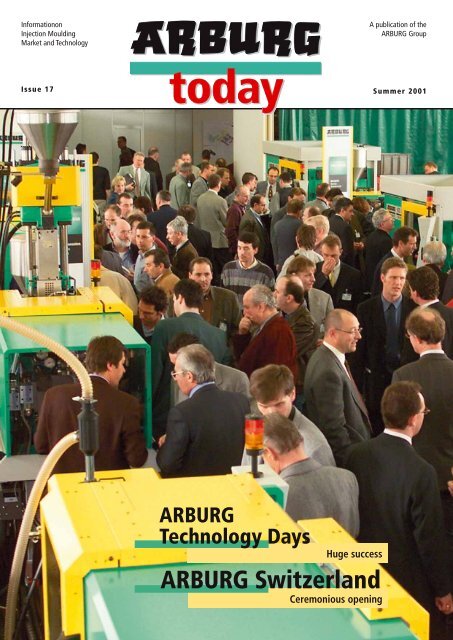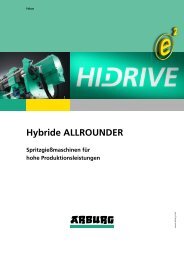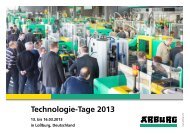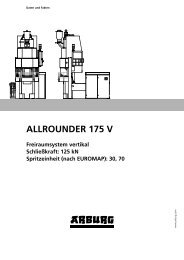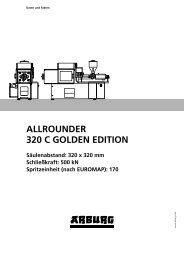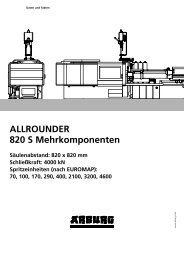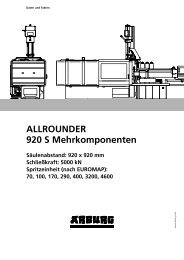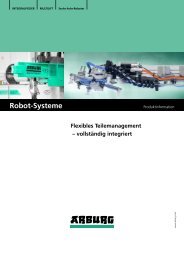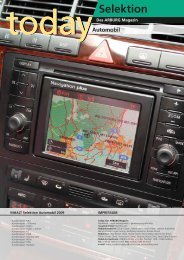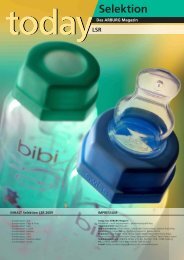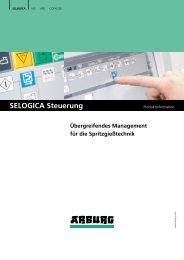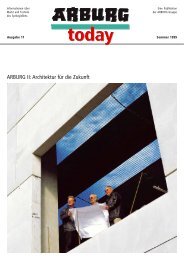GB - Arburg
GB - Arburg
GB - Arburg
You also want an ePaper? Increase the reach of your titles
YUMPU automatically turns print PDFs into web optimized ePapers that Google loves.
Informationon<br />
Injection Moulding<br />
Market and Technology<br />
Issue 17<br />
ARBURG<br />
Technology Days<br />
Huge success<br />
ARBURG Switzerland<br />
Ceremonious opening<br />
A publication of the<br />
ARBURG Group<br />
Summer 2001
Contents<br />
ARBURG Technology Days<br />
The concept takes off<br />
ARBURG customer report<br />
Injection unit puts the lid on cartons<br />
ARBURG subsidiaries<br />
The new look for Switzerland<br />
ARBURG technology<br />
The perfect twist: unscrewing using electric<br />
core pull control<br />
The big question: how is the 630 S getting on?<br />
ARBURG customer report<br />
Cooperation on several levels<br />
ARBURG subsidiaries<br />
ARBURG spol. s r. o.: on course for success<br />
ARBURG projects<br />
Projects from one source<br />
ARBURG history<br />
Milestones<br />
Tech Talk<br />
Optimising production with the ARBURG host<br />
computer system ALS 4.0<br />
IMPRINT<br />
Editor: Dr. Christoph Schumacher (resp. for content)<br />
Editorial Advisory Board:<br />
Juliane Hehl, Martin Hoyer,<br />
Roland Paukstat, Bernd Schmid,<br />
Jürgen Schray, Renate Würth<br />
Contributors to this issue:<br />
Uwe Becker (text), Markus Mertmann (photos),<br />
Marcus Vogt (text), Vesna Serti� (photography),<br />
Susanne Wurst (text), Peter Zipfel (layout)<br />
2<br />
3-5<br />
6-7<br />
8<br />
9<br />
10-11<br />
12<br />
13<br />
14<br />
15<br />
Editorial address:<br />
ARBURG GmbH + Co<br />
Postfach 1109<br />
72286 Lossburg<br />
Tel.: +49 (0) 7446/33-3149<br />
Fax: +49 (0) 7446/33-3413<br />
e-mail: today_kundenmagazin<br />
@arburg.com<br />
www.arburg.com<br />
If you didn't visit our Technology Days yourself, you've almost certainly<br />
already heard the story of their amazing success: around 3,100 experts<br />
over three days spells out a very clear message – particularly as this is<br />
also a K year!<br />
It is reassuring for us to see: the interest shown by our customers in our<br />
company and our innovative technology has not waned, indeed appears to<br />
carry on growing, if that is still possible. It appears then that our pursuit of<br />
practical orientation is also paying off for our customers.<br />
But it's not only in Germany where such brilliant events are taking place:<br />
We also celebrated the opening of a new subsidiary building in Switzerland,<br />
which reveals a very obvious connection with our headquarters even<br />
when seen from outside.<br />
The K exhibition draws closer and closer: at this point we would very much<br />
like to invite you to come and visit us on our stand 13 A 13. It will be<br />
worth your while!<br />
Happy reading!<br />
Juliane Hehl<br />
Rush hour in the ARBURG<br />
demonstration room –<br />
fi lled to the brim with ARBURG<br />
technology:<br />
One of the focal points at the Technology<br />
Days in March 2001 was the demonstration<br />
room, where 21 of the 40 high tech<br />
exhibits were on display.<br />
Eugen Hehl<br />
ARBURG today, Issue 17 / Summer 2001 Customer magazine of the ARBURG Group Reproduction - even in part - only by express permission
The concept takes off<br />
The ARBURG Technology<br />
Days were visited by<br />
3.100 experts from<br />
around the world this year.<br />
They traditionally take place<br />
at the end of March in Lossburg.<br />
That means attendance<br />
was up around 50 percent on<br />
the previous record set last<br />
year.<br />
The huge numbers of visitors to<br />
the Technology Days was clear evidence<br />
that the concept of the threeday<br />
event, providing a comprehensive<br />
overview of the ARBURG range<br />
and excellent presentations by experts,<br />
was very well received - even<br />
in a year when K is due to take place.<br />
It also shows how great the appeal<br />
of open house at ARBURG is for<br />
customers.<br />
Overall, 3,100 visitors made their<br />
way to Lossburg from a total of 23<br />
different countries, including such<br />
far away places at Bulgaria, Romania,<br />
Hong Kong and Taiwan. Overall,<br />
guests from abroad constituted<br />
around one third of all visitors.<br />
Just as in previous years, Friday<br />
saw the biggest crowds: a total of<br />
1,400 visitors beating the attendance<br />
record for a single day, which<br />
Operation is child's play.<br />
was also set last year, by over 50<br />
percent. The fact that things didn't<br />
get too crowded was largely thanks<br />
to the diverse range of information<br />
sources.<br />
A packed programme<br />
These enabled visitors to see the<br />
ARBURG technology in action on 40<br />
exhibits, spread throughout the demonstration<br />
rooms, laboratories and<br />
the exhibition area in Hall 10. They<br />
could also fi nd out more through<br />
pre-sentations given by experts<br />
and special shows taking place in<br />
the training rooms. Factory tours<br />
were available as well, taking guests<br />
through the various areas of production,<br />
and when all this proved too<br />
much, they could take a well-earned<br />
break in the ARBURG Allround Center.<br />
On all three days there were huge crowds in the demonstration room.<br />
The 40 machine exhibits gave<br />
trade visitors a complete overview<br />
of the whole range of ARBURG<br />
products and, using a variety of different<br />
applications, demonstrated<br />
what can be achieved with ARBURG<br />
technology.<br />
All products at a glance<br />
The whole line-up of machines<br />
was on display: from the smallest<br />
ALLROUNDER 220 S with a clampi-<br />
ARBURG Technology Days<br />
ing force of 150 kN, right up to<br />
the largest currently available, the<br />
ALLROUNDER 630 S with 2,500 kN<br />
of clamping force. ARBURG's robotic<br />
system, MULTILIFT H, was<br />
also shown in various applications.<br />
In addition to demonstrations<br />
of multi-component injection<br />
moulding, optical disc application,<br />
smart card and PET<br />
pre-moulded part production, and<br />
thermoset, elastomer and silicone<br />
processing; special Gram mould<br />
technology was on display, as<br />
was the Mucell ® process, which<br />
has been available from ARBURG<br />
for some time now.<br />
3
ARBURG Technology Days<br />
4<br />
INTERVIEW<br />
Wilhelm Kaiser Sr.<br />
Herr Kaiser, at 90 years old<br />
you are our eldest visitor. It is<br />
a great pleasure for ARBURG<br />
to welcome you here.<br />
W.K.: The feeling is quite mutual.<br />
It is also a great pleasure for me<br />
to be here to share with you such<br />
a splendid event. Over time, I have<br />
witnessed quite a few of the events<br />
at ARBURG.<br />
How far back do your ties<br />
with ARBURG go?<br />
W.K.: Well, I did buy my fi rst machine<br />
back in 1959 – when Arthur<br />
Hehl was still at the helm – at the<br />
Hanover exhibition, after originally<br />
becoming involved with thermoset<br />
presses in 1936. Today our company,<br />
with its 40 members of staff, is<br />
a supplier to Ford and VW amongst<br />
others.<br />
That also makes you one of<br />
our longest-standing customers.<br />
Why are you so attached<br />
to ARBURG?<br />
W.K.: I have always regarded<br />
ARBURG as a highly reputable company<br />
and a leader in terms of technology,<br />
which has meant that all<br />
the machines we have bought in<br />
the last ten years have been<br />
ALLROUNDERs.<br />
That means ARBURG has accompanied<br />
and helped you<br />
through more than 40 years<br />
of your professional life?<br />
W.K.: Yes, you could certainly say<br />
that. And as a ten year old my son,<br />
Wilhelm Kaiser Jr., also spent many<br />
an hour in production, in front of<br />
this fi rst ARBURG machine. You see<br />
then, our whole family is tied up<br />
with ARBURG.<br />
Additionally, visitors had the<br />
chance to familiarise themselves<br />
with the SELOGICA graphical user<br />
interface on simulators during the<br />
special shows, or take a closer look<br />
at the various different spare parts.<br />
Huge crowds for the factory<br />
tours<br />
The factory tours proved particularly<br />
interesting for guests visiting<br />
ARBURG for the fi rst time: it was<br />
a chance to see how and where<br />
their ALLROUNDERs are produced.<br />
But even the regulars, those who<br />
come to Lossburg for the Technology<br />
Days every year, took the opportunity<br />
to see what goes on behind<br />
the scenes at ARBURG, in the<br />
ARBURG Technology Days 2001:<br />
The three-day event brought in the crowds with the varied<br />
programme of 40 high tech exhibits, presentations by<br />
experts, technical discussions and factory tours.<br />
Young and old came along to Lossburg.<br />
course of one of the tours. Throughout<br />
the three days, factory tours<br />
conducted in German and foreign<br />
languages were taking place continually.<br />
Overall, more than 80 percent<br />
of the guests took part in the<br />
factory tours, and in the case of<br />
the foreign visitors, this fi gure was<br />
close to reaching 100 percent.<br />
As last year, the highlight was the assembly<br />
hall at newly built ARBURG II,<br />
with its 3000 square metre façade<br />
made entirely of glass. Visitors were<br />
astonished to think of how much had<br />
been achieved there in the course<br />
of the last year: what last year had<br />
been an empty hall had now come to<br />
life: ALLROUNDER production was<br />
in full swing.<br />
ARBURG Project Group makes<br />
itself known<br />
A source of great interest to<br />
many of the trade visitors were the<br />
displays of two customer projects<br />
in the fi eld of complete production<br />
cells, on display in Hall 10. Developing<br />
the theme of production cells -<br />
currently a hot topic at ARBURG -<br />
was a specialist presentation entitled<br />
"ARBURG – Projects from one<br />
source", which introduced the new<br />
ARBURG Project Department itself<br />
and gave details of various customer<br />
projects.<br />
Also on the programme of presentations<br />
to be given by experts<br />
was one on "Combining hard/soft
materials with thermoplastic elastomers",<br />
a report given by Uwe<br />
Stenglin from the German company<br />
PTS.<br />
The topics of two further presentations<br />
focused on ARBURG's host<br />
computer system (ALS). Providing<br />
background information was an expert<br />
from ARBURG, who went online<br />
during his presentation to log<br />
into production taking place in<br />
the ARBURG demonstration room,<br />
thereby providing a practical illustration<br />
of the benefi ts of ALS.<br />
ALS as seen by the customer<br />
Providing the customer's perspective<br />
was Markus Zäch from the<br />
Swiss company, Technoplast. He described<br />
how ALS has helped his<br />
company optimise production. During<br />
his very well attended presentation,<br />
Zäch explained that his company's<br />
investment in an ARBURG host<br />
computer system had paid for itself<br />
within seven months. He thereby<br />
disproved the popular misconception<br />
that production control systems<br />
are too expensive and that their use<br />
is therefore uneconomical. Both of<br />
these presentations were complemented<br />
by the special show on ALS/<br />
AQS.<br />
Thanks to these presentations<br />
by specialists, given in both English<br />
and German languages, trade visitors<br />
could take home with them a<br />
great deal of detailed theoretical information.<br />
ARBURG Technology Days<br />
INTERVIEW<br />
Markus Zäch, Technoplast<br />
What was the feedback like<br />
from the visitors?<br />
M.Z. Very positive. The questions<br />
were largely about missed opportunities<br />
in the past, but also about the<br />
work time model we chose, which<br />
enabled us to increase our capacity<br />
signifi cantly. There were a few interesting<br />
discussions about the methodology<br />
of how we've gone about<br />
things, which began with a very<br />
time-consuming analysis of PPS and<br />
ALS. Unfortunately, most companies<br />
are put off by the effort involved,<br />
although this opens up a wealth of<br />
potential.<br />
What was the response like<br />
after the event?<br />
M.Z. There were about 20 interested<br />
parties, to whom we provided<br />
a written copy of the seminar paper.<br />
Numerous people were interested in<br />
taking a tour of the factory. The industry<br />
press are also set to run two<br />
specialised articles about Technoplast<br />
Engineering and the ALS system<br />
used.<br />
What experiences did you<br />
take away with you?<br />
M.Z. The discussions with other ALS<br />
users showed me that, by using the<br />
ALS data, we have achieved considerable<br />
time-management and economic<br />
advances. We also appear to<br />
be on the right tracks in terms of using<br />
our internal capacity to the full,<br />
the availability of installations and<br />
exploiting all the potential available.<br />
We have to ensure we continue<br />
along this path and constantly develop<br />
our methodology.<br />
5
6<br />
ARBURG customer report<br />
Injection uni<br />
puts the lid on ca<br />
Tetra Pak integrates ARBURG injection units in<br />
Both the injection moulding of the top and the screwing on of the cap is integrated in the Tetra<br />
Top system.<br />
In its Tetra Top product<br />
line, Swedish company Tetra<br />
Pak has a packaging system<br />
in its range requiring a<br />
further operating stage, taking<br />
place after the drinks carton<br />
is manufactured but before<br />
the carton then goes on<br />
to be fi lled: injection moulding<br />
of the polyethylene "top"<br />
using an ARBURG injection<br />
unit that is integrated into<br />
the complete system.<br />
At the start of the 1950s, Tetra<br />
Pak started out as one of the fi rst<br />
companies involved with packaging<br />
milk. Since then, it has become<br />
one of the world's biggest suppliers<br />
of packaging systems for milk,<br />
fruit juices and other liquid or viscose<br />
products. In 1991, Tetra Pak<br />
extended its fi elds of operations to<br />
include process systems for processing<br />
liquid foodstuffs, system construction,<br />
and equipment for producing<br />
cheese. Today, it is therefore<br />
the only company in the world that<br />
can offer integrated solutions and<br />
systems for processing, packaging<br />
and distributing liquid and viscose<br />
foodstuffs.<br />
Tetra Pak worldwide<br />
Currently around the world there<br />
are 77 Tetra Pak marketing companies,<br />
68 production plants for<br />
packaging material, including franchises,<br />
and twelve assembly plants<br />
for packaging machines. In the<br />
year 2000, the company employed<br />
18,900 workers and had a turnover<br />
of 7.3 million Euro. Tetra Pak products<br />
are sold in more than 165<br />
countries. In the year 2000, Tetra<br />
Pak produced 89 billion packages<br />
throughout the world.<br />
Tetra Pak's products can be separated<br />
into the following categories:<br />
carton packaging systems and<br />
carton material, plastic packaging<br />
systems, distribution systems, and<br />
processing lines from product receipt<br />
to processing and packaging.<br />
The Tetra Top product line<br />
For its Tetra Top product area,<br />
the company's range includes the<br />
TT/3 processing line. This line takes<br />
care not only of manufacturing the<br />
drink carton, but also the injection<br />
moulding of the PE top and the fi lling<br />
process.<br />
The sequence of procedures involved<br />
breaks down roughly into<br />
the following stages:<br />
First of all, a cut-out of the shape required<br />
for the packaging is cut from<br />
the paper-polyethylene binder material,<br />
which reaches the machine<br />
in the form of rolls. This is then<br />
shaped into the body of the packaging<br />
– a drinks carton that is open at<br />
both top – and bottom. The crosssection<br />
is a square with rounded<br />
edges. In the next stage,<br />
the PE top is injected<br />
onto the body of the carton<br />
from beneath. There<br />
is an overlap of around<br />
fi ve millimetres between<br />
plastic and carton, which<br />
is sealed tightly. Then<br />
the product is poured in<br />
and the base is sealed.<br />
The fi rst Tetra Top<br />
machine of the 1980s<br />
was the single-tracked<br />
TT/1, which was joined<br />
in 1992/93 by the twotracked<br />
TT/3. Production<br />
of the TT/1 was discontinued<br />
in 1997. The ad-<br />
vantages of the TT/3 lie in the<br />
two, separate packaging lines and<br />
the double product tanks. This arrangement<br />
allows simultaneous fi lling<br />
with two different products on<br />
a single machine. As well as this,<br />
two different volume sizes with different<br />
top and base formats can be<br />
put through the system at the same<br />
time.<br />
Last year, Tetra Top<br />
brought a revised<br />
version of the system<br />
onto the market,<br />
the TT/3 ESL.<br />
The particu lar advantage<br />
here lies<br />
in the sterilisation<br />
of the cartons,meaning<br />
that
t<br />
rtons<br />
its packaging systems<br />
fresh milk packed in the cartons<br />
keeps longer.<br />
Integrated injection unit<br />
The injection units used for injection<br />
moulding in the Tetra Top<br />
systems are supplied exclusively by<br />
ARBURG. These were modifi ed specially<br />
for this application: for example,<br />
they have longer guide rods<br />
and purpose made non-return<br />
valves. Otherwise,<br />
the injection<br />
units used<br />
are the standard<br />
versions<br />
that can be found on ALLROUNDER<br />
machines. For the purposes of<br />
testing, Tetra Pak also has an<br />
ALLROUNDER that is used for the<br />
test injection of newly developed<br />
tops, prior to producing them on<br />
the TT/3 machine.<br />
9,000 pieces per hour<br />
When a new machine is installed,<br />
the user must decide which<br />
packaging family – Base, Mini or<br />
Midi – is to be used on the individual<br />
lines. Using the full capacity of both<br />
lines on the TT/3, it is possible to produce<br />
up to 9,000 Tetra Top packages<br />
per hour, or 4,500<br />
per line.<br />
On the TT/3 system<br />
it is possible to produce up to<br />
9,000 Tetra Toppackages per hour.<br />
Photos: Tetra Pak<br />
The cooperation between Tetra<br />
Pak and ARBURG has been going<br />
on for many years, since the mid<br />
1980s when the fi rst Tetra Top machines,<br />
the TT/1s, came onto the<br />
market. From the very fi rst version<br />
of the Tetra Top machine to the<br />
current TT/3, the injection units<br />
used have been supplied solely by<br />
ARBURG.<br />
Three sizes – six tops<br />
The Tetra Top product portfolio<br />
is made up of three families of packages:<br />
Base, Mini and Midi. These<br />
cover volume sizes at capacity intervals<br />
ranging between 250 and<br />
1,000 millilitres. The areas of the<br />
bases, and therefore the injection<br />
moulded tops, come in 70 x 70,<br />
47 x 47 or 57 x 57 millimetre sizes. In<br />
terms of the tops, six different variations<br />
are available: the range of<br />
options available comprises various<br />
different sizes of screw caps (central<br />
ScrewCap, off-centre or stackable),<br />
ring pull openers (RingPull<br />
and GrandTab with straw hole) and<br />
completely removable tops (Total<br />
Tab). In the case of the screw caps,<br />
the top is injected together with<br />
the outer thread. The screw-on cap<br />
with its inner thread is screwed on<br />
in a separate machine, the so-called<br />
"Cap Applicator".<br />
The products in Tetra Top drink<br />
cartons are sold in 19 countries,<br />
with the main markets being found<br />
in Great Britain, Greece, Norway,<br />
Brazil, Korea and Japan.<br />
ARBURG customer report<br />
Extremely practical: milk in the Tetra Top pack<br />
with ring-pull top.<br />
7
ARBURG subsidiaries<br />
Lots of interest in the showroom.<br />
The new look for Switzerland<br />
Aglass façade, well-defi<br />
ned shapes, modern<br />
design in sophisticated<br />
ARBURG style: No, we're not<br />
talking about ARBURG's headquarters<br />
in Lossburg here but<br />
about the new building at the<br />
subsidiary in Switzerland.<br />
In mid May, ARBURG AG marked<br />
the opening of its new building<br />
in Münsingen with two lavishly-organised<br />
events which were attended<br />
by well over a hundred guests.<br />
On the Friday Eugen Hehl, the chairman<br />
of the management team, was<br />
present to carry out the offi cial<br />
opening of the architecturally adventurous<br />
new construction. The<br />
following day, which was declared<br />
an open day, customers, Münsingen<br />
residents, and anybody else who<br />
might be interested were invited to<br />
visit.<br />
The festivities had been perfectly<br />
prepared by Peter Moser,<br />
the manager of the subsidiary: The<br />
8<br />
Exquisite architecture.<br />
new building was gleaming out, a<br />
marquee had been put up in the<br />
grounds outside, all the assembled<br />
guests and employees were rounded<br />
up – and just in time for the<br />
hoisting of the ARBURG fl ag in<br />
front of the building which marked<br />
the start of the offi cial opening,<br />
the dark rain clouds, which had<br />
been lurking ominously in the sky<br />
previously, dispersed.<br />
And lending his own hand at<br />
the base of the fl agpole was Eugen<br />
Hehl: the ceremony had been<br />
planned by Peter Moser as a surprise<br />
for the chairman of the management.<br />
Thereafter, the guests<br />
released a large number of white<br />
balloons they had been given previously,<br />
all marked with the ARBURG<br />
logo, into the sky. Eugen Hehl cut<br />
the traditional opening ribbon and<br />
stepped through a row of staff<br />
members standing in front of the<br />
entrance portal. He was accompanied<br />
by his son Michael, by the<br />
director of sales Michael Grandt<br />
Speakers: Eugen Hehl (l) and Peter Moser (r).<br />
Peter Moser, Michael Grandt, Eugen Hehl, Stephan Doehler and Michael Hehl (l. to r.).<br />
and by the head of European sales,<br />
Stephan Doehler.<br />
ARBURG has been represented<br />
in Switzerland by its own subsidiary<br />
since the start of 1994. For the<br />
fi rst seven years, the Swiss subsidiary<br />
operated out of a rented building<br />
in Belp. Münsingen lies in the<br />
centre of Switzerland, close to Bern,<br />
and is therefore strategically in a<br />
better location. The fi rst cut of the<br />
spade came on 14 March 2000, signifying<br />
the offi cial start to construction<br />
of the ARBURG Technology<br />
Center (ATC) on the 3,000 square<br />
metre site.<br />
ARBURG invested more than<br />
four million Swiss Francs in<br />
constructing the two-storey building.<br />
Alongside the modern offi ces,<br />
the 1,070 square metres of fl oorspace<br />
also accommodate a wellstocked<br />
spare parts warehouse and<br />
a demonstration room as a forum<br />
for presenting all the ARBURG products.<br />
Equipped with the latest generation<br />
of ALLROUNDERs, it gives<br />
customers the opportunity to see<br />
ARBURG technology in action. On<br />
the one hand, by seeing examples of<br />
applications, they can gain a useful<br />
insight into the machine and control<br />
system technology as well as<br />
the various applications for which<br />
the ALLROUNDER can be used. At<br />
the same time, though, the demonstration<br />
room also serves as a place<br />
where customers can carry out tests:<br />
try out a new mould for example, or<br />
receive practical assistance to deal<br />
with injection moulding problems<br />
arising in practice.<br />
On Saturday, hoards of people<br />
turned up, basking in the glorious<br />
weather of early summer: Accompanied<br />
by the uplifting tones of a<br />
Dixieland band playing in the marquee,<br />
the new building was given<br />
a close inspection. Peter Moser and<br />
his team had taken the day's motto<br />
quite literally so it really was a case<br />
of the whole building being left<br />
wide open to all.
The perfect twist:<br />
Unscrewing using<br />
the electric<br />
core pull control<br />
Precision and repeatability<br />
are in constant demand,<br />
especially when<br />
unscrewing high quality<br />
threads on technical injection<br />
moulded parts. Using<br />
unscrewing units with<br />
servo-electric drive mechanisms,<br />
it is possible to<br />
achieve very precise position<br />
regulation in all ejection<br />
movements.<br />
The basis for this is the electric<br />
core pull control, which can be used<br />
for all applications that are traditionally<br />
associated with the hydraulic<br />
core pull. The main difference<br />
lies in each movement being<br />
controlled servo-electrically. In conjunction<br />
with the absolute system<br />
of measuring used, it is possible<br />
to achieve substantially better positioning<br />
accuracy. As well as this,<br />
drive is possible independently of<br />
the hydraulic axes<br />
on the machine,<br />
meaning it can be<br />
operated at the<br />
same time as all<br />
other machine<br />
movements.<br />
Complete integration<br />
in the SELOGICA<br />
machine control system via a standardised<br />
interface makes the combination<br />
look even more interesting.<br />
The individual movements can<br />
be programmed in directly and precisely<br />
using the system's own screen<br />
displays – no mechanical adjustment<br />
on the mould itself is necessary.<br />
The type of axis movement<br />
required can be switched between<br />
linear and rotating movement, that<br />
is between power, speed and path or<br />
torque, rev speed and rotation. Even<br />
if the user installs an additional, intermittent<br />
linkage, the SELOGICA<br />
machine control system<br />
recalculates all<br />
the parameters involved<br />
once the transmission<br />
ratio has been input.<br />
As well as the very precise position<br />
regulation and repeatable accuracy,<br />
there are other benefi cial<br />
factors to its use in unscrewing<br />
units: a higher maximum torque rating<br />
and the option of trouble-free<br />
programming for various different<br />
steps. That means that intermittent<br />
stops, etching of the thread with<br />
the mould closed or continuous rotation<br />
can be programmed directly.<br />
Unscrewing unit with servo-electric<br />
drive: precisely programmable using the<br />
electric core pull control.<br />
Precision ejection: thermostat with internal and external threads.<br />
All functionalities are stored together<br />
with the corresponding mould<br />
data record, meaning that when<br />
a mould is changed, all the relevant<br />
data is immediately available.<br />
Improved operator comfort, shorter<br />
set-up times and better security<br />
against operating errors are the immediate<br />
advantages of this shared<br />
data record.<br />
ARBURG technology<br />
The big question:<br />
how is the 630 S<br />
getting on?<br />
It was hoped that a follow-up<br />
telephone campaign<br />
by ARBURG, aimed<br />
at customers already using<br />
the 630 for production in<br />
their machine shops, would<br />
shed a little light on this<br />
question. "The reason is<br />
simple," as Eberhard Lutz,<br />
head of domestic sales, says:<br />
"Prior to this, we had received<br />
no feedback from<br />
the customers about our big<br />
ALLROUNDER or customer's<br />
experiences of its use in the<br />
fi eld. And that can be positive<br />
as well as negative!"<br />
To clear this up straight away:<br />
the results of the representative<br />
ARBURG survey were very nearly<br />
all positive. The machines are<br />
either being used for testing purposes<br />
or are already fully integrated<br />
and being fully exploited<br />
in production. The companies reported<br />
no problems with the basic<br />
machine technology or the<br />
special features such as the platen<br />
adjustment.<br />
Apart from two very minor<br />
leaks there were no complaints<br />
whatsoever. These diffi culties can<br />
be put down to "teething troubles"<br />
and could be rectifi ed very<br />
swiftly as a result. This reassuringly<br />
very positive fi rst feedback<br />
suggests that even the biggest<br />
machine ever from the "S Class"<br />
has been received extremely well<br />
by the market.<br />
It should be even more interesting<br />
when additional processing<br />
procedures and new features<br />
are added, making its application<br />
even more universal. The keywords<br />
in this context are "multi-component<br />
injection moulding"<br />
and "optimised hydraulics<br />
for faster drive movements".<br />
9
ARBURG customer report<br />
Festo AG & Co. and<br />
ARBURG: two companies<br />
that can look back on<br />
cooperation stemming back<br />
around 25 years. The cooperation<br />
becomes even more<br />
special due to the fact that<br />
both companies are doubly<br />
connected with one another.<br />
Because Festo is both a customer<br />
of, and a supplier for<br />
ARBURG. So logically it follows<br />
that the reverse is also<br />
true.<br />
The Festo Group, which incorporates<br />
not only Festo AG + Co, but<br />
also Festo Didactic & Co. as a training<br />
and education facility, Beck IPC<br />
Teamwork plays a major role in developing and<br />
implementing new ideas at Festo.<br />
GmbH and FCC GmbH, the latter<br />
helping the group out in matters relating<br />
to marketing, advertising and<br />
exhibition management; is active<br />
in the business sector of automation<br />
using pneumatic components<br />
and systems. The Didactic branch<br />
looks after the training and education<br />
with a focus on industrial automation.<br />
The company's main product<br />
groups are drive units, handling accessories<br />
and vacuum technology,<br />
valves, sensors and push switches,<br />
and tubing, screw fi ttings, and both<br />
pneumatic and electronic control<br />
system technology. Festo does not<br />
only manufacture standard products<br />
in these areas, but also solutions<br />
for specifi c fi elds and applications.<br />
They also provide combinations<br />
of pneumatic and electronic<br />
10<br />
Cooperation on<br />
components which are used for mechanical<br />
engineering and handling<br />
technology applications.<br />
Impressive fi gures<br />
A look at its homepage at<br />
www.festo.com reveals some impressive<br />
fi gures about the company:<br />
In the year 2000, the group's<br />
turnover amounted to 1,200 million<br />
Euro, accumulated by 10,050 employees<br />
across the globe. The Festo<br />
Group is represented by its own<br />
locations in 176 countries around<br />
the world, and its international client<br />
base numbers 300,000. Global<br />
production sites are found in Brazil,<br />
Bulgaria, India, Korea, Mexico,<br />
Ukraine, Hungary and in the USA, in<br />
addition to which there are customer<br />
specifi c manufacturing plants in<br />
27 countries.<br />
Returning to Germany. Festo headquarters<br />
has been located in Esslingen<br />
Bergheim since the company was<br />
founded in 1925. As well as this site,<br />
there is also the customer service centre,<br />
the Festo's learning centre in Saar<br />
and the cylinder production plant, all<br />
The right tool for the job: an ALLROUNDER 420 C for three-component processing: integrated into a<br />
production cell for manufacturing pistons for cylinders.<br />
of which are in St. Ingbert-Rohrbach.<br />
The current product range comprises<br />
16,400 components, the numbers of<br />
variants of which run into hundreds of<br />
thousands. Cooperation based on<br />
personal esteem.<br />
The enterprising families Stoll<br />
and Hehl have known and valued<br />
each other for years. This then became<br />
the basis for all the commercial<br />
links between the companies<br />
which have developed over<br />
the years. ARBURG sources various<br />
different pneumatic components<br />
from Festo, to be used in<br />
its own production as well as on<br />
the ALLROUNDERs. The cooperation<br />
has been extended particularly<br />
noticeably in the course of the<br />
last year. ARBURG's development<br />
and marketing of its own robotic<br />
equipment – in the MULTILIFT series –<br />
led to very close, exclusive collaboration<br />
between the two companies,<br />
to deal specifi cally with this project.<br />
Festo components are integral parts<br />
of both the pneumatic and the servo-electric<br />
drive train, with parts<br />
such as valves, pneumatic cylinders,<br />
pneumatic sliding units or axles for<br />
toothed belts. Screw fi ttings and<br />
piping complete the list of items included<br />
in the supply arrangement.<br />
In fact, the level of cooperation<br />
looks set to increase still further in<br />
the future as the MULTILIFT range of<br />
robotic equipment is extended and<br />
enlarged.<br />
As far as cooperation working<br />
in the other direction is concerned,<br />
there is plenty of clear evidence<br />
referring to the customer Festo in<br />
ARBURG's machine history. Ever<br />
since the 1960s, the company has<br />
relied upon the ALLROUNDER for<br />
manufacturing its own injection<br />
moulded parts for its extensive<br />
range of products. According to<br />
Michael Maas, head of production<br />
at the plastic injection plant in<br />
St. Ingbert-Rohrbach, these have<br />
been technical parts in the main.<br />
Using 980 injection moulding<br />
moulds, around 1,200 items are
several levels<br />
Showing the way: the Festo production site in St. Ingbert-Rohrbach, Saarland<br />
now manufactured for the company's<br />
own production. As well as<br />
plastic production at the St. Ingbert<br />
site, they also undertake their<br />
own mould construction and mould<br />
manufacture.<br />
The machine line-up that Festo<br />
has built up over the course of time<br />
includes ALLROUNDER 220 and 270<br />
models, the 305 ECO and a few<br />
CMD models, right up to the latest<br />
ALLROUNDER C and S models. Furthermore,<br />
three ALLROUNDER T<br />
rotary table machines have also<br />
been integrated into production,<br />
these being used mainly for injecting<br />
around inserts or multi-component<br />
injection moulding applications.<br />
Since the collaboration with<br />
ARBURG began, Festo has used 43<br />
ALLROUNDERs in its production.<br />
At the present time, one 320 C,<br />
three 420 C, two 420 S and<br />
three THERMOLIFT granule predryers<br />
and conveyors are at<br />
the delivery stage. This machine<br />
fleet is supplemented with two<br />
ALLROUNDERs in the Bulgarian<br />
branch of Festo and two further<br />
machines can be found at the<br />
learning centre in St. Ingbert-<br />
Rohrbach.<br />
Festo also entrusts its production<br />
monitoring and quality control<br />
to ARBURG products. In these areas,<br />
the company uses an ALS master<br />
computer system in conjunction<br />
with an AQS quality assurance system<br />
and a machine-based AQC quality<br />
control system connected to an<br />
ALLROUNDER 420 S. Working with<br />
ARBURG, Festo has also developed<br />
Pneumatic components supplied by Festo set the ARBURG MULTILIFT in motion (left).<br />
Neat: a view of injection moulding production in St. Ingbert-Rohrbach (right). Photos: Festo<br />
and produced manufacturing cells,<br />
specially adapted for their manufacturing<br />
needs. An example of this:<br />
The production cell built around an<br />
ALLROUNDER 420 C for three-component<br />
processing, comprising material<br />
preparation and feeding using<br />
THERMOLIFT, removal by a robotic<br />
system, and coordinated placement<br />
in appropriate trays prior to further<br />
processing. Pistons for pneumatic<br />
cylinders made of magnetic material<br />
are manufactured using this confi<br />
guration, with a thermoplastic being<br />
used as a carrier.<br />
Benefi ts of ARBURG<br />
injection moulding<br />
technology<br />
According to Michael Maas, the<br />
benefi ts of using ARBURG and<br />
ALLROUNDER injection moulding<br />
technology are primarily the uncomplicated<br />
cooperation, the excellent<br />
cost-effectiveness, the speedy<br />
delivery of replacement parts, even<br />
other than ARBURG's own components,<br />
and the thoroughly competent<br />
staff for consulting about all<br />
matters involving plastic.<br />
Cooperating is always a fruitful<br />
exercise if it benefi ts both sides involved.<br />
It really comes into its own,<br />
ARBURG customer report<br />
however, when both sides involved<br />
receive excellent support as both<br />
a customer of, and supplier to the<br />
other partner. If a further consequence<br />
of this cooperation then<br />
leads to further links on other levels<br />
as well, there is real justifi cation<br />
for describing this as a truly universal<br />
partnership. This is certainly<br />
the case with Festo and ARBURG.<br />
Another example is Festo's training<br />
centre in St. Ingbert-Rohrbach: for<br />
several years, ARBURG has been<br />
able to take advantage of these<br />
facilities to run its own training<br />
courses for customers in the local<br />
area. The two companies are already<br />
planning further cooperation<br />
in this sector. A clear indication that<br />
this full-scale cooperation is well<br />
and truly on the right tracks.<br />
11
ARBURG subsidiaries<br />
ARBURG spol. s r.o.:<br />
Team talk: currently still based at rented premises in Prague.<br />
The story of success just<br />
continued to snowball:<br />
eight years ago, ARBURG<br />
was almost unheard of on<br />
the injection moulding machine<br />
market of what was<br />
then the Republic of Czechoslovakia.<br />
Nowadays, this mechanical<br />
engineering company<br />
is at number 1 on the<br />
list of importers with its own<br />
subsidiary in Prague, ARBURG<br />
spol. s r.o.<br />
For the fi rst three years, ARBURG's<br />
affairs in the Republic of Czechoslovakia<br />
were still conducted by a trading partner.<br />
Because of the success the ALLROUNDER<br />
was having on the market in Czechoslovakia,<br />
however, a new ARBURG subsidiary<br />
- ARBURG spol. s r.o. - was founded<br />
in Prague. As achieved very successfully<br />
when establishing other ARBURG subsidiaries<br />
in the past, members of staff<br />
from the previous trading partner were<br />
taken over into the new company, making<br />
the transition as seamless as possible.<br />
Because the division of the Republic<br />
of Czechoslovakia into two<br />
independent states – the Czech Republic<br />
and the Slovak Republic – resulted<br />
in a number of administrative<br />
and organisational diffi culties,<br />
particularly with regard to supplying<br />
spare parts and support ser-<br />
12<br />
Set for success<br />
vices, a regional offi ce was originally<br />
set up in Brno in the Czech<br />
Republic, close to the border with<br />
Slovakia. This was followed by the<br />
creation of an independent organisational<br />
section at Vrutky in Slovakia.<br />
There, one service engineer is<br />
solely responsible for the support<br />
of the Slovak customers while the<br />
other four look after the Czech<br />
customers. Sales is also divided<br />
up into two areas, with Michal<br />
Slaba taking over the western<br />
area including Bohemia and the<br />
western part of Moravia, and Jiri<br />
Zelma looking after the remainder<br />
of Moravia and the Slovak<br />
Republic.<br />
Overall, the team at the Czech<br />
subsidiary arm of ARBURG is made<br />
up of the subsidiary manager<br />
Jaroslav Novak and eleven members<br />
of staff looking after Administration,<br />
Accounts, Sales, Service<br />
and the Spare Parts section.<br />
After eight years of having a<br />
presence on both the Czech and Slovak<br />
markets – including fi ve years<br />
as the offi cial company subsidiary –<br />
the Czech ARBURG subsidiary has<br />
Jaroslav Novak (3rd from right), manager of the Czech subsidiary of ARBURG, with his team.<br />
more than 100 companies with over<br />
800 injection moulding machines<br />
on its list of customers, and the<br />
trend is continuing. The majority of<br />
these customers are from the automotive<br />
and electronics industry.<br />
With ARBURG's continued<br />
growth and success – number one<br />
importer of injection moulding machines<br />
for the last three years –<br />
gradually things are becoming a little<br />
cramped in the existing, rented<br />
premises. However, the solution to<br />
this problem of space is close at<br />
hand: an area of land in Brno has<br />
already been bought, where a new<br />
building for the Czech subsidiary is<br />
soon to be built. The architecture<br />
will follow the familiar ARBURG<br />
style. By bringing the two Czech<br />
sites together, this will establish<br />
a central port of call. The new<br />
building, consisting of two storeys<br />
providing usable fl oorspace of 900<br />
square metres, offers plenty of<br />
space to accommodate offi ces, a<br />
well-equipped spare parts storeroom<br />
and a demonstration room.<br />
On a 230 square metre exhibition<br />
area, the customers will be able<br />
to gather information about the latest<br />
ARBURG technology; test out<br />
an ALLROUNDER with their own<br />
mould, if required; or receive further<br />
training in one of the sessions<br />
organised.<br />
A lot of customers make their<br />
way to Germany, however, to attend<br />
the ARBURG Technology Days<br />
in Lossburg for example, where<br />
they can also fi nd out more about<br />
the latest developments in injection<br />
moulding technology as well as<br />
taking a look behind the scenes at<br />
how the company works. Some also<br />
come along to visit ARBURG at the<br />
Fakuma exhibition in Friedrichshafen<br />
or K in Düsseldorf.<br />
The most important national exhibitions<br />
as far as the Czech subsidiary<br />
is concerned are the international<br />
machine exhibitions at Nitra<br />
in Slovakia and Brno in the Czech<br />
Republic, where the ALLROUNDER<br />
was awarded a Gold Medal in both<br />
1998 and 2000.
Projects from one source!<br />
More and more companies<br />
are demanding<br />
automated manufacturing<br />
cells for producing injection<br />
moulded parts, which<br />
are tailor-made for their specifi<br />
c needs and available from<br />
a single source. This gives a<br />
main contractor full control to<br />
provide support to customers<br />
from planning the whole system<br />
to being put into service<br />
and looking after all the servicing<br />
and aftercare arrangements.<br />
ARBURG has taken these requirements<br />
on board, as demanded<br />
by the market, by establishing<br />
a specialised project department,<br />
which is headed by Oliver Giesen.<br />
The department is assigned to the<br />
Sales division and has at its disposal<br />
all the technical and business management<br />
know-how that it needs<br />
to provide comprehensive support<br />
to all project customers.<br />
Good examples of the kind of<br />
complete projects carried out in this<br />
way are, amongst others: combined<br />
part removal and placement, injecting<br />
around inserts, repositioning<br />
of moulded parts within the mould<br />
for multi-component applications,<br />
or even further processing after removal<br />
by downstream stations for<br />
printing or ultrasonic welding.<br />
Ideas soon become a reality<br />
Altogether six members of staff<br />
look after bringing project related<br />
tasks into reality. Once fi eld servicing<br />
has determined the principle<br />
diffi culties involved, the project<br />
group comes up with the necessary<br />
concepts and hardware layouts, providing<br />
different variations where<br />
necessary. The fi nancial transparen-<br />
cy demanded by the customer is<br />
made available from the very start,<br />
as short-term statements relating to<br />
the costs involved are supplied by<br />
a budget proposal, the details of<br />
which are discussed with the customer<br />
afterwards as well as at subsequent<br />
meetings. Once the customer<br />
has given his consent, the actual<br />
work can begin. The peripheral<br />
components have to be coordinat-<br />
ed with the various different suppliers,<br />
interfaces synchronised and<br />
the whole installation put together<br />
under production conditions at the<br />
company, in preparation for offi cial<br />
New perspectives: Group leader<br />
Oliver Giesen (centre) with his staff<br />
Sandra Geiss, Gerd Ruoss, Jörg<br />
Heinzelmann, Christoph Hipp and<br />
Martin Neff (left to right).<br />
In conjunction with customers, the<br />
project group develops, plans and<br />
produces complex manufacturing<br />
cells, complete with downstream<br />
peripheral components. The support<br />
provided covers everything<br />
from commissioning and CE<br />
certifi cation to after sales service.<br />
acceptance by ARBURG and the customer.<br />
Cost-effectiveness is vital<br />
Oliver Giesen admits there are<br />
long-standing project partners, but<br />
they would also be open to any requests<br />
from customers that are appropriate.<br />
In terms of choosing the<br />
technology, the primary concern is<br />
not to get the best price but to fi nd<br />
the best cost-benefi t ratio. The project<br />
team makes full use of the extensive<br />
knowledge within the company<br />
when trying to make the best<br />
ARBURG projects<br />
use of the synergies between machine,<br />
mould and technology for automation<br />
and simplifying the process<br />
as a whole.<br />
In any case, the customers can<br />
be sure they have a solution that<br />
is perfectly adapted to the needs of<br />
their production. The heart of all these<br />
projects is always the SELOGICA<br />
machine control system which is<br />
used to operate the whole installation.<br />
ARBURG's own MULTILIFT robotic<br />
systems are always integrat-<br />
ed into the control sequence: in<br />
the case of other components, the<br />
same occurs by adapting the interface<br />
technology. Detailed safety engineering<br />
does not only provide the<br />
necessary procedural and therefore<br />
production security, it also ensures<br />
the safety of the whole installation<br />
using the appropriate protective<br />
guarding.<br />
After acceptance at ARBURG,<br />
the production unit is put into action<br />
at the customer's plant and, if<br />
required, the appropriate CE certifi<br />
cation can also be provided. And<br />
even after production has begun,<br />
customers will still have the right<br />
contact in ARBURG: maintenance<br />
and spare part supplies for all parts<br />
of the equipment is carried out<br />
through ARBURG. Even the engineers<br />
from suppliers can be brought<br />
into action if the situation requires<br />
it. Total support from a single source:<br />
ARBURG now offers its customers<br />
this complete service through<br />
its own project team!<br />
13
ARBURG history<br />
14<br />
MILESTONES<br />
Electro-mechanical dosage<br />
- a milestone at<br />
ARBURG? But that's only<br />
been available from ARBURG<br />
since 1997, some of you may<br />
be thinking. Well not quite because<br />
there was a dosage system,<br />
powered by an electric<br />
motor, back in the early 1960s<br />
on the ALLROUNDER 200, the<br />
fi rst ARBURG injection moulding<br />
machine equipped with a<br />
screw.<br />
The ALLROUNDER 200 with electric<br />
dosage drive was part of<br />
ARBURG's range for around ten<br />
years, from the start of the 1960s to<br />
the start of the 1970s. Back in the beginning,<br />
a D.C. motor was used for<br />
the dosage drive - something of an<br />
innovation back then. The big advantage<br />
of the D.C.<br />
motor was that<br />
the rev speed<br />
could be varied.<br />
Increased<br />
production by reducing<br />
the cycle time and energy<br />
savings of up to 20 percent: strong arguments<br />
for an electro-mechanical dosing unit.<br />
But, as is often the case with<br />
new ideas, although the principle<br />
of the D.C. motor was good, the<br />
technology wasn't quite sophisticated<br />
enough. The control system<br />
was very intricate - it required a<br />
large, additional control box - and<br />
was therefore prone to disruption,<br />
so the costs were relatively high as<br />
a result.<br />
For this reason it was decided<br />
that an A.C. motor should be used<br />
for the dosage drive, the controls<br />
for which were far simpler. The<br />
change, however, brought with it<br />
the disadvantage that the rev speed<br />
could no longer be varied, unlike<br />
the D.C. motor, but was constant<br />
instead.<br />
To provide an alternative for<br />
those users who didn't want to<br />
lose their variable rev speed<br />
facility, two versions of the<br />
ALLROUNDER 200 were made<br />
available: customers<br />
could choose between<br />
the D variant with the A.C. motor,<br />
or the H version with hydraulic motor,<br />
on which the rev speed was infi<br />
n i t e l y v a r i a b l e .<br />
Even in those days, ARBURG was<br />
using its familiar modular component<br />
system. The injection unit was<br />
equipped with a fl exible interface,<br />
to which both A.C. and hydraulic<br />
motors could be connected. Over<br />
time, the hydraulic motor became<br />
the norm, so the electric motor used<br />
for dosing was dropped from the<br />
range.<br />
Until in 1997, ARBURG extended<br />
its modular machine concept to include<br />
electro-mechanical dosage, initially<br />
on the C machines, sizes 420 C,<br />
470 C and 520 C with injection units<br />
350 and 675. Today, an electro-mechanical<br />
dosage unit is available for<br />
all ALLROUNDERs used in conjunction<br />
with the 350, 675 and 1300<br />
injection units.<br />
At the same time, the SELOGICA<br />
machine control system provides<br />
a simple<br />
sequence display and easy programming<br />
even where there are simultaneous<br />
drive moments.<br />
Using the electro-mechanical<br />
system makes the dosing axis independent<br />
of the machine hydraulic<br />
supply. This makes for better<br />
material preparation because when<br />
movements take place concurrently,<br />
it is possible to operate using a lower<br />
rev speed for the screw. This in<br />
turn is benefi cial to the overall process:<br />
Although throughput stays the<br />
same, the level of material shearing<br />
is lower, melting homogeneity<br />
improves and the material temperature<br />
can be lowered. That reduces<br />
the time needed for cooling and<br />
therefore the overall cycle time. Consequently,<br />
using electro-mechanical<br />
dosage drive, productivity is effectively<br />
increased because of the reduction<br />
in cycle time, giving an energy<br />
saving at the same time, which<br />
could be as much as 20 percent over<br />
the whole cycle.
ALLROUNDER for<br />
TU in Clausthal<br />
The Institute for Polymer<br />
Materials and Plastics Engineering<br />
(PuK) at the<br />
Technological University in<br />
Clausthal uses two ARBURG<br />
ALLROUNDERs for teaching<br />
and research purposes. To<br />
gain an insight into the enormous<br />
scope for using and<br />
processing polymer materials,<br />
the head of state for Lower<br />
Saxony, Sigmar Gabriel, visited<br />
the institute at the beginning<br />
of March.<br />
Founded in the winter semester<br />
of 1998/99, the director of the<br />
institute, Prof. Dr. Ing. Gerhard<br />
Ziegmann, has managed to establish<br />
impressive working structures,<br />
even in terms of the equipment<br />
available to them, in quite a short<br />
space oftime.<br />
For its work in single and multi-component<br />
injection moulding,<br />
the institute has turned to the<br />
ARBURG ALLROUNDER. ARBURG<br />
supplemented their purchase of an<br />
ALLROUNDER 420 C 1000-150/60,<br />
used to produce injection moulded<br />
parts using two components,<br />
with the loan of a type 320 C<br />
600-250 machine to cater for conventional<br />
injection moulding of<br />
plastics. At the institute, the two<br />
ALLROUNDERs are used in all the<br />
different areas such as multi-com-<br />
Lower Saxony's head of state, Sigmar Gabriel (3rd from left), gave the signal to start production using the<br />
ALLROUNDERs. Joining him in the celebrations were (from the left): Michael Bosse and Prof. Gerhard<br />
Ziegmann (from the PuK), and Haiko Tessendorff and Wolfgang Knop (from ARBURG).<br />
ponent injection moulding, including<br />
for hard-soft combinations, ceramic<br />
and powder injection moulding<br />
or for processing polymers<br />
fi lled with magnetic powder.<br />
The state president appeared<br />
impressed by the institute's capabilities,<br />
its facilities and the variety<br />
of technology used. He was<br />
also very impressed by the material<br />
itself and the number of applications<br />
that can be found for it<br />
in everyday life.<br />
Making best use of the<br />
capacity and fl exibility<br />
of an existing<br />
machine fl eet can give even<br />
the small injection moulding<br />
company that competitive<br />
edge. This necessitates the increased<br />
use of data processing<br />
systems such as the ARBURG<br />
host computer system ALS 4.0,<br />
which records machine and<br />
batch data and thereby makes<br />
the whole manufacturing sequence<br />
more transparent.<br />
To exploit the potential for optimising<br />
production, it is vital to<br />
establish effective monitoring and<br />
documentation of the whole production<br />
process. Even the basic platform<br />
of the modular host computer<br />
system provides an up-to-date overview<br />
of the production currently<br />
taking place, being connected to<br />
the machines via the recognised<br />
world standard of Ethernet cabling<br />
network.<br />
Using the machine and plant<br />
data acquisition facilities of this basic<br />
system, the user of an ALS Workstation<br />
can keep constantly upto-date<br />
on production within the<br />
company. Starting with a graphic<br />
representation of the machine hall,<br />
it is possible to call up detailed information<br />
such as status data, plant<br />
data and process parameters at any<br />
time by simply clicking on the appropriate<br />
machine symbol. Where<br />
process fl uctuations or interruptions<br />
in production may arise, it is possible<br />
to take preventative action.<br />
In addition, this data is continuously<br />
recorded in different data pools,<br />
allowing statistical analysis of the<br />
machine data over various different<br />
time periods. At the same time, all<br />
results can be printed and exported<br />
in the form of tables or graph-<br />
Tech Talk<br />
Optimising production<br />
with the ARBURG host<br />
computer system ALS 4.0<br />
TECH TALK<br />
Dipl.-Ing. (FH) MARCUS VOGT Technical information<br />
ics, meaning that ALS data can be<br />
used as the basis for analysing production<br />
over the long-term. The capacity<br />
and availability of machines<br />
and moulds – and therefore how effi<br />
ciently the tasks are managed –<br />
can be established over a long period<br />
of time using actual production<br />
data. Analysing all the data that is<br />
gathered will then reveal how much<br />
potential exists for optimising current<br />
manufacturing procedures.<br />
Starting with this ALS base platform,<br />
the system can then be adapted<br />
to the specifi c requirements of a<br />
particular company using additional<br />
component modules. Other system<br />
components such as task management<br />
based on a schematic planning<br />
chart, order transfer from existing<br />
production planning systems,<br />
quality data recording and management<br />
of confi guration data records<br />
can be added to the base platform<br />
stage by stage.<br />
15
13 A 13!* 13!*<br />
*<br />
Die "K „K 2001": 2001“: the Ihre gate Eintrittskarte into a whole range in völlig of new neue dimensions! Dimensionen! Your Der code Code for entering zum Eintritt the world in die<br />
Technikwelt of technology des in 3. the Jahrtausends: third millennium: 13 A 13. 13 A Viel 13. Spaß We wish auf Ihrer you well Entdeckungstour!<br />
on your voyage of discovery!<br />
ARBURG GmbH + Co<br />
Postfach 1109 · 72286 Lossburg<br />
Tel.: +49 (0) 7446 / 33-0<br />
http:// www.arburg.com<br />
e-mail: contact@arburg.com


